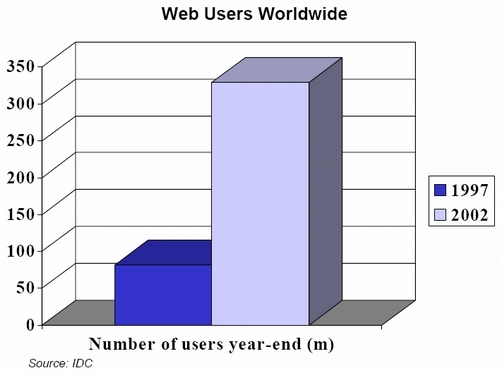XML: The Global Meta Data Standard
By David Marco
XML (eXtensible Markup Language) is one of the hottest areas in all of technology today. In fact it’s difficult to find a magazine that doesn’t have one or more articles addressing this topic in one manner or another. In this month’s column we will look at how XML is impacting the meta data industry and the reasons why XML will impact every corporation in the world.
Many companies (Sun Microsystems in particular) believe that the network is the database. If this is true then Internet web pages have become the biggest database of them all. With e-business solutions expected to grow to well over a $100 billion industry by the year 2002 and the number of web users projecting to reach 329 million by 2002 (see Figure 1) this database will continue to grow at an exponential rate.

Figure 1: Web Users Worldwide
Besides being the largest database in the world, the web is also the largest distributed environment in the world. As this heterogeneous environment continues to grow at this ever-escalating rate it will become more and more difficult to manage and control it. What many companies have realized is that there needs to be a way to take this disparate data and make it homogeneous. Meta data provides this answer…its called XML. XML and its related standards are attempting to solve this problem of heterogeneous data. XML was developed by the World Wide Web Consortium (W3C) and it looks to accomplish this by attaching “data tags” tags in HTML (hypertext markup language) that describe the data (meta data) on a web page. To understand how these data tags function let’s use XML to describe the information about a text book:
<Book>
<Name>The Complete XML Guide</Name>
<Author>
<Name>John Smith</Name>
<Title>Jr.</Title>
</Author>
<Year>1999</Year>
<Publisher>John Wiley & Sons</Publisher>
<PubCity>New York</PubCity>
<Edition>First</Edition>
</Book>
As we can see this tag-based approach offers a flexible and extensible mechanism to handle the meta data associated with information content (i.e., each tag name describes the characteristic of the data it specifies). XML’s strength comes from the fact that it allows data on the web to be put in any order because it is the data tag, not the location of the data that describes the data’s meaning.
XML is so important that it is even a bigger meta data “story” than the meta model standards being developed by the Meta Data Coalition and the Object Management Group. This is mainly because XML is visible to a much larger audience, namely the web. These efforts hope to trigger a convergence of XML with the meta model standards whether they be the Meta Data Coalitions or the Object Management Groups or both. This would provide a “Holy Grail” to corporations as it gives them the opportunity to manage their legacy system of the future, before it becomes too large to handle…the web. That’s right the web is our legacy system of the future. As we’ve previously mentioned the web is the largest database and distributed system in the world. Moreover it is also the largest decision support system ever created. The biggest problem with the web today is finding the information we want. For example, a number of months ago I wanted to see if there were any books written on the topic of meta data. In order to accomplish this I utilized various Internet search engines to try and locate any books I could on meta data. I fired up the search engine and looked for “meta data books”. My search returned literally thousands of matches. Unfortunately none of these matches pointed me to an actual book on meta data. I must admit I did give up looking after scrolling through a hundred or so of the web pages that were returned. With my situation above the XML “data tags” would have clearly indicated which sites had information about meta data in the title of a book.
XML’s goal is to provide the “glue” (or meta data) that adds meaning to all of this “stuff” on the web. XML would allow the Internet search engines to look at a web page and to identify when it locates an actual book or when just the word “meta data book” appears. This functionality would enable corporations to be able to communicate with one another by reading each other’s website, and through customized (ad hoc) exchange of electronic commerce transactions and through direct XML-based interfaces. Without XML it will be impossible (like today) for companies to exchange documents (web pages) over the Internet without building custom program interfaces or manual intervention.
Keep in mind that XML, like the meta model standards are still maturing but both are moving very fast as there is a great deal of market pressure to develop a solution quickly. XML is well on its way to becoming the global meta data standard for the web.